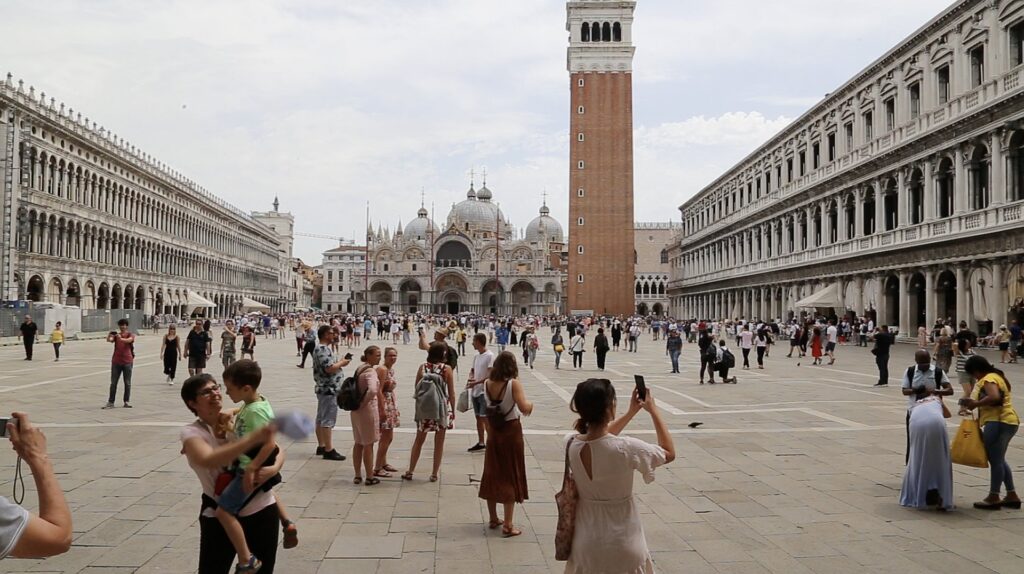
Imaginations of Venice
Exhibition Venice BEREal
Meinblau Art Space, Pfefferberg, Berlin European Month of Photography EMOP
Opening: Friday 28. February 2025 | 18:00 – 22:00
Duration: 1. – 23. March 2025 | Thursday-Sunday, 14:00 – 19:00
All the images Venice has spread around the world for centuries, what ideas and expectations has it triggered and how do these images and expectations shape the city of Venice today?
Berlin-based artist Stefanie Bürkle has been photographing Venice on her travels for the last 30 years. In 2022-2025, she realized Imaginations of Venice, an artistic research project as part of the CRC 1265 Re-Figuration of Spaces at the TU Berlin.
The artist sees her own image production as part of the global circulation of images, a loop in which Venice is fixed, reproduced, reduced and multiplied as a projection foil for diverse spatial imaginations. With Venice BeReal, she is now presenting the results of the project for the first time.
Her Venice Atlas, an artistic archive of images of Venice, is at the core of the exhibition. In addition to analog and digital photographs, video excerpts from project interviews provide insights into Venice’s realities. A central video work transcends the artistic archive from Stefanie Bürkle’s studio into the exhibition space amidst the visitors.
Art and Research Project : Imaginations of Venice – Migrating Spaces and Tourism II
Venice was and is being copied and reproduced manifold: casinos from Las Vegas to Macao, theme parks in China, all the way to the many Venezia ice cream parlours (Bürkle 2002) that sprung up in the wake of Italian migration in small and medium-sized German cities. The copies and reproductions imagine, vary and scale fragments of the Serenissima just as Marco Polo’s fictional travel reports from the invisible cities (Calvino 1977[1972]).
Venice offers a projection surface for diverse spatial imaginaries, therefore it is very well suited as a case study for Stefanie Bürkle’s artistic research project (in the context of the collaborative research center of the TU, HU, FU Berlin CRC 1265 Re-Figuration of Spaces), as it links the artistic discourse around image (Bild), ideal-image (Vorbild), copy (Nachbild) and perceived-image with the discourse around reconfiguration in the social sciences on different levels. Stefanie Bürkle has already addressed different imaginaries of Venice in her work, through photographic series such as Eiscafé Venezia in Germany and Window of the World in Shenzhen, China. In occasion of the project, new artistic work on this theme (photography, video, and painting) will be created.The circulation of goods (trade), images and people has been the defining element of the city of Venice since its foundation. After Corona, which on the one hand represented a “recovery” for Venice, but on the other hand, just like the flood in 2019, an existential crisis, the aggravation of the spatial consequences and of the spatial conflicts brought along by over-tourism and gentrification, among other things, is now becoming more evident than ever.
In Venice, tourist behavioral patterns exist in dealing with the ever same reproduced image of the city, but also a multi-layered, spatial and temporal overlapping of tourism, migration and residents.
Imaginations of Venice artistically and visually investigate contemporary phenomena of Venice (and its copies). Stefanie Bürkle’s project is, in the broadest sense, an exploration of travel and of the appropriation of imaginations of the foreign and thus of the known. Behavioral patterns at tourist sites in Venice and its replicas in Las Vegas, Macao and Shenzhen are put in relation to one another. Across time (historical travel reports) and media formats (from the veduta, to postcards, guidebooks, and Instagram selfies), images create touristic expectations, which in turn influence the shaping of Venice as a city.
These copies (Nachbildungen), as well as de-pictions (Abbildungen) in the form of photographs or postcards, work their way up into the structural and visual design of Venice; they nest in the bodies of viewers; they continually motivate new places in the world to build a piece of Venice. These reproductions, however, are not simply copies or simulations, but appropriated re-creations. Terms such as construction site, stage, façadism, and ruin, with which Stefanie Bürkle works in her oeuvre (face-facade 1999-2021), play a decisive role in this approach.
The development and realisation of the artistic research and works, as well as a publication and exhibition on the project Imaginations of Venice 2022-2025 by Stefanie Bürkle and her interdisciplinary team is, as a subproject of the CRC 1265 “Re-Figuration of Spaces”, funded by the DFG (German Research Foundation).
Exhibition Venice BeReal
1.-23. March 2025 at Meinblau Artspace Berlin as part of the European Month of Photography (EMOP)
5.-28. September 2025 at the Palazzetto Tito in Venice in collaboration with the Fondatione Bevilacqua La Masa parallel to the Architecture Biennale 2025
Publication: An Exhibition Guide Atlas of An exhibition catalog with extended thematic text contributions on the images of Venice, decay and construction sites, ruins, historical photographs, historical and contemporary travel reports
The Collaborative Research Center CRC 1265 “Re-Figuration of Spaces” is a network of more than 60 researchers from the Technical University of Berlin, the Humboldt University of Berlin, the Free University of Berlin, the University of Vienna and the Institute for Regional Planning in Erkner, who, in its 15 subprojects, are dedicated to researching the socio-spatial and the digital transformation of urban spaces.
Deutsche Forschungsgesellschaft, Sonderforschungsbereich SFB1265 Re-Figuration von Räumen www.sfb1265.de